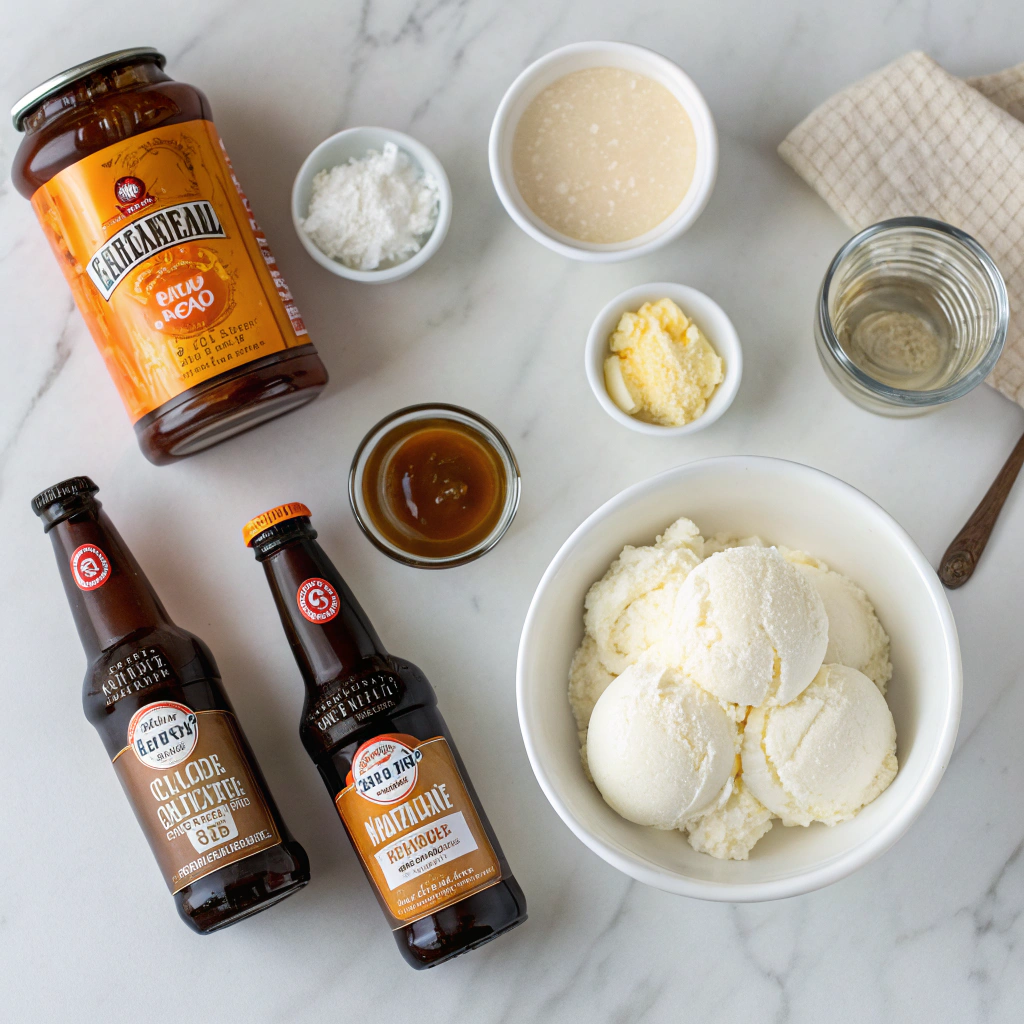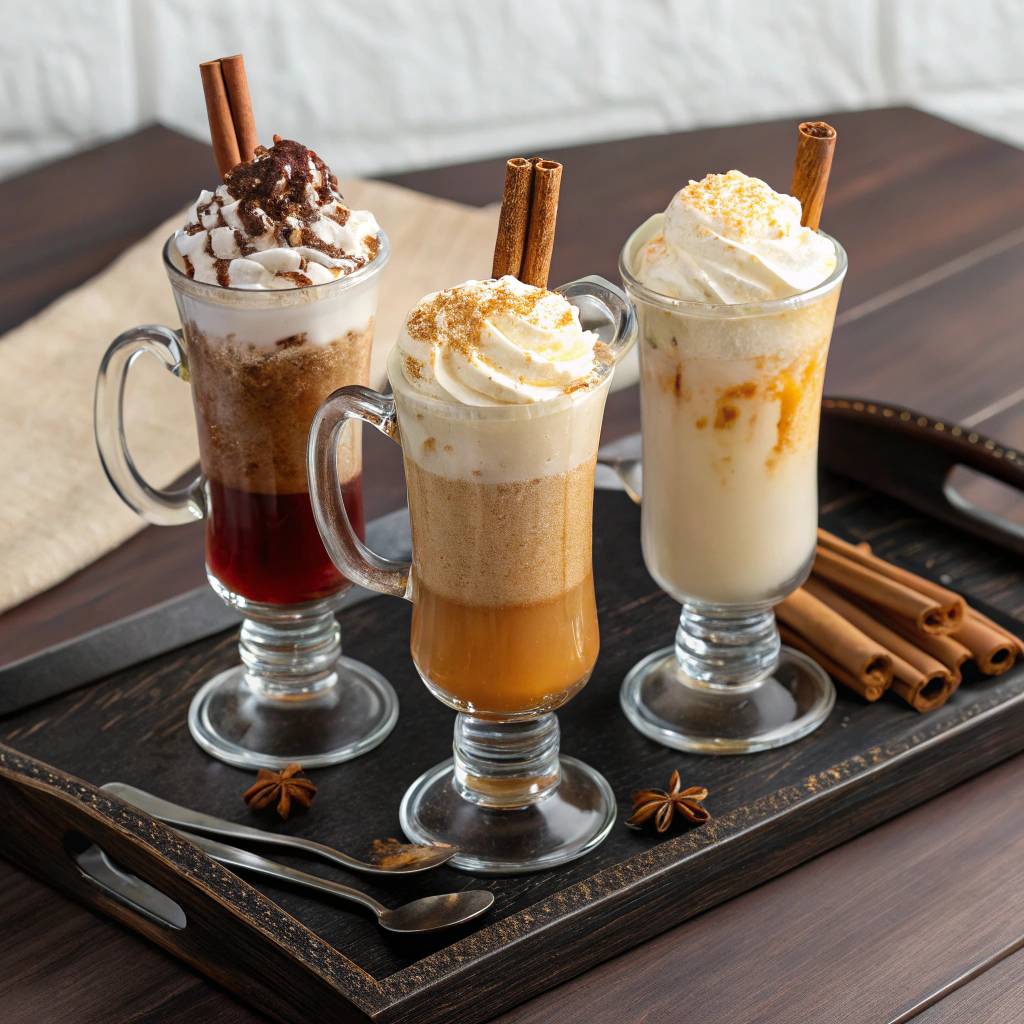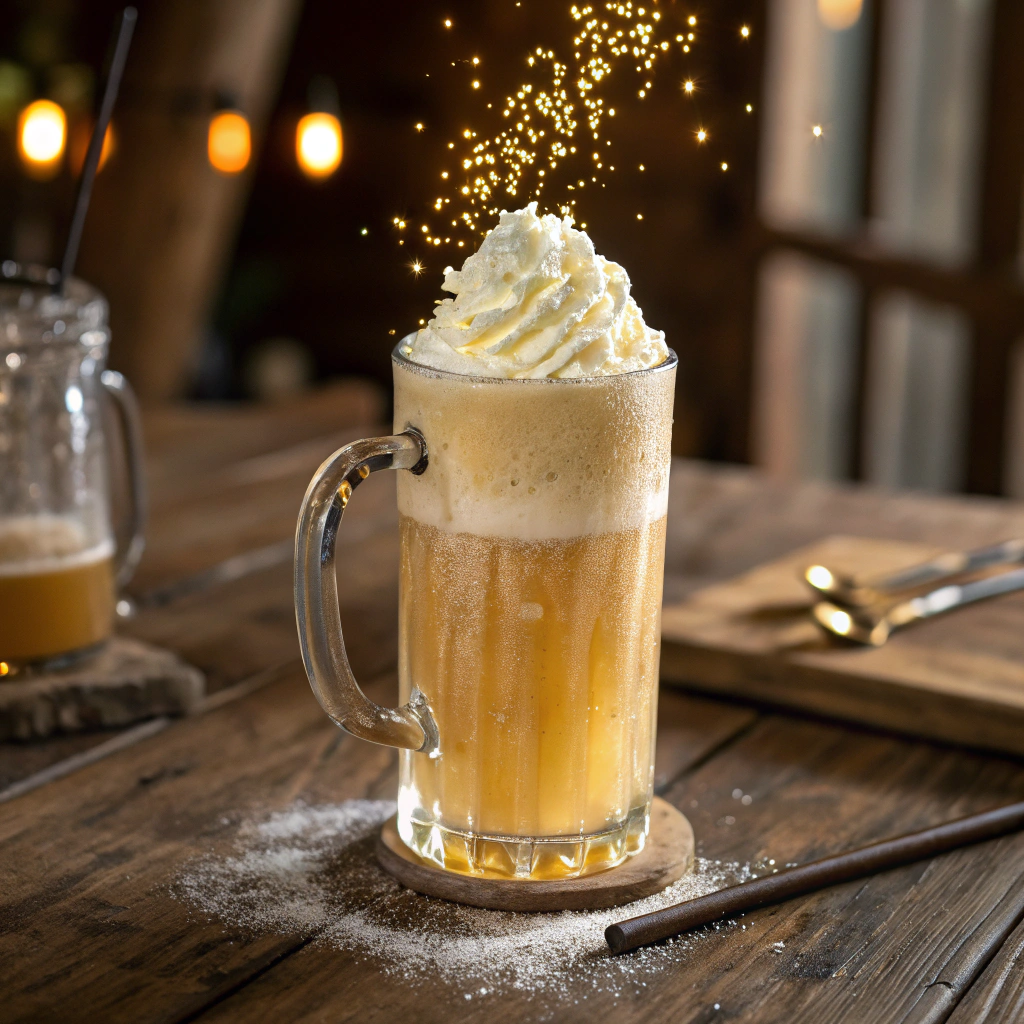Transform your kitchen into the Three Broomsticks with the perfect butterbeer float recipe that rivals the wizarding world’s most beloved beverage. This magical drink has captured the hearts of Harry Potter fans worldwide, offering the perfect blend of sweetness, creaminess, and nostalgic charm that transports you straight to Hogsmeade Village.
While store-bought versions are expensive and hard to find, and many homemade attempts fall short of achieving that signature creamy foam and authentic butterscotch flavor, this comprehensive guide solves those frustrations. You’ll master the art of creating butterbeer floats with simple ingredients and professional techniques that deliver consistent, delicious results every time.
Whether you’re planning a Harry Potter party drink spread or simply want to enjoy a magical treat at home, this recipe provides everything needed to create the authentic taste and presentation that makes butterbeer floats so special. According to the official Wizarding World description of butterbeer, this beloved drink should have a rich butterscotch flavor with a warming, comforting quality that we’ll perfectly recreate.
Table of Contents
Table of Contents
What Makes the Perfect Butterbeer Float
Creating an authentic butterbeer float requires understanding the essential components that separate a magical experience from a disappointing imitation. The perfect balance involves three critical elements: flavor profile, texture, and visual presentation that work together to create the complete wizarding world experience.
Essential Flavor Profile Components
The foundation of any exceptional butterbeer float recipe lies in achieving the perfect butterscotch-forward taste. This requires a delicate balance of cream soda’s vanilla notes, rich butterscotch undertones, and subtle caramel hints that create depth without overwhelming sweetness. The flavor should be warming and comforting, reminiscent of autumn afternoons and cozy fireplaces.
Professional food scientists recommend layering flavors rather than relying on a single dominant taste. The base cream soda provides effervescence and vanilla foundation, while butter extract adds the signature richness that gives butterbeer its name. A touch of caramel syrup rounds out the profile, creating complexity that keeps each sip interesting.
Texture Requirements for Authenticity
Texture plays an equally important role in authentic butterbeer recreation. The drink should offer multiple textural experiences: the smooth creaminess of vanilla ice cream, the light bubbles from quality cream soda, and most importantly, the thick, stable foam topping that defines the visual and tactile experience.
The ice cream must be perfectly tempered – not too hard that it creates chunks, nor too soft that it dissolves immediately. The foam topping requires specific techniques to maintain stability, preventing the common problem of deflation that ruins the presentation within minutes of serving.
Visual Presentation Standards
Visual appeal determines the first impression and sets expectations for the entire experience. The perfect butterbeer float displays distinct layers: golden amber liquid in the middle third, creamy vanilla ice cream providing body, and a generous crown of white foam that reaches just above the rim.
The color should be reminiscent of liquid gold or amber honey, achieved through proper ingredient ratios and mixing techniques. The foam must maintain its height and structure throughout the drinking experience, creating Instagram-worthy presentation that captures the magical essence fans expect.
Essential Butterbeer Float Ingredients and Substitutions
Success with any butterbeer float recipe depends entirely on selecting the right ingredients and understanding how each component contributes to the final result. Quality ingredients make the difference between a mediocre drink and a truly magical experience that rivals theme park versions.
Primary Base Ingredients
The foundation requires premium cream soda as your base liquid. Brands like A&W, IBC, or Virgil’s provide the best vanilla flavor profiles, though regional preferences may vary. You’ll need 12 ounces per serving, chilled to 35-40 degrees Fahrenheit for optimal carbonation retention.
Vanilla ice cream serves as both flavor enhancer and textural component. Premium brands with higher fat content (14-16%) create superior creaminess and melting characteristics. Häagen-Dazs and Ben & Jerry’s consistently deliver the rich texture needed for professional results. Plan for 2-3 generous scoops per float.
Butter extract provides the signature butterscotch essence that transforms ordinary cream soda into magical butterbeer. McCormick or Nielsen-Massey offer the most authentic flavoring – use 1/4 teaspoon per serving, as too much creates an artificial taste that overwhelms the delicate balance.

Foam Topping Components
The iconic foam requires heavy whipping cream (at least 35% fat content), marshmallow creme or fluff, and vanilla extract. This combination creates the stable, sweet foam that defines the butterbeer float experience. Some recipes substitute ice cream, but traditional marshmallow-based foam provides superior stability and authentic taste.
For enhanced flavor depth, add butterscotch pudding powder (1 tablespoon) to the foam mixture. This intensifies the butterscotch notes while adding natural thickening properties that improve foam longevity.
Dietary Alternative Options
Modern butterbeer float recipes must accommodate various dietary needs without sacrificing flavor or presentation. For those following dairy-free dessert alternatives, coconut-based ice cream substitutes provide similar richness, while oat milk cream works excellently for foam preparation.
Sugar-conscious individuals can substitute cream soda with sugar-free versions, though flavor profiles may vary slightly. Stevia-sweetened ice cream alternatives maintain the creamy texture while reducing overall sugar content by approximately 40%. According to dietary modification guidelines, these substitutions can significantly reduce caloric content while maintaining taste satisfaction.
Vegan adaptations require plant-based ice cream (cashew or coconut base works best) and aquafaba-based foam preparations. While the flavor profile differs slightly from traditional versions, proper seasoning with vanilla and butterscotch extracts creates surprisingly authentic results.
Step-by-Step Butterbeer Float Recipe Instructions
Mastering the butterbeer float technique requires attention to timing, temperature, and layering methods that professional bartenders use to create consistent, beautiful results. Follow these detailed instructions for perfect results every time.
Preparation and Setup
Begin by chilling all components to optimal temperatures: cream soda at 35-40°F, glasses in the freezer for 15 minutes, and ice cream slightly softened (remove from freezer 5-10 minutes before use). Room temperature ingredients create poor carbonation retention and unstable foam.
Prepare your workspace with all ingredients within easy reach. You’ll need tall glasses (12-16 ounce capacity), an ice cream scoop, measuring spoons for extracts, and mixing bowl for foam preparation. Professional timing is crucial – once you begin assembly, work quickly to maintain carbonation and prevent ice cream melting.
Mix the foam topping first, as it benefits from 5-10 minutes of settling time. Combine 1/2 cup heavy cream, 2 tablespoons marshmallow fluff, 1/4 teaspoon vanilla extract, and 1 tablespoon butterscotch pudding powder. Whip to medium peaks – not stiff, as over-whipped cream becomes grainy and less stable.
Layering Technique for Perfect Presentation
Start each butterbeer float by adding butter extract directly to the chilled glass – 1/4 teaspoon per serving. This ensures even distribution throughout the drink rather than creating concentrated pockets of flavor.
Add the first scoop of vanilla ice cream gently to avoid splashing. Pour cream soda slowly down the side of the glass, filling approximately halfway. The slow pour preserves carbonation while preventing excessive foam formation that can overflow the glass.
Add the second and third ice cream scoops, positioning them to create visual interest rather than uniform placement. Pour the remaining cream soda, leaving 1-2 inches of space at the top for the foam crown.
For techniques similar to those used in vanilla ice cream dessert recipes, allow 30-60 seconds for initial settling before adding the foam topping. This prevents the foam from sinking immediately into the liquid.
Timing for Optimal Results
Apply the foam topping using a large spoon or piping technique, creating a generous dome that extends slightly above the rim. The foam should be applied within 2-3 minutes of liquid assembly to ensure proper adhesion and stability.
Serve immediately after foam application – butterbeer floats are best enjoyed within 5-7 minutes of completion, before carbonation dissipates and foam begins deflating. Professional establishments serve these drinks on individual trays with long spoons and thick straws for optimal enjoyment.
Temperature management remains critical throughout service. If preparing multiple servings, complete each drink individually rather than assembly-line style, ensuring each guest receives their float at peak quality and presentation.
Butterbeer Float Variations for Every Taste
Expanding your butterbeer float repertoire allows you to accommodate different preferences, dietary restrictions, and seasonal celebrations while maintaining the magical essence that makes this drink special. These variations provide creative alternatives without sacrificing the authentic butterscotch experience.
Dietary Modification Versions
Sugar-free butterbeer float variations utilize diet cream soda and sugar-free vanilla ice cream, reducing overall carbohydrate content by approximately 60%. Substitute regular butterscotch extract with sugar-free butterscotch syrup, available from specialty baking suppliers or online retailers.
Dairy-free butterbeer versions require coconut-based ice cream and aquafaba foam preparation. Coconut cream ice cream provides the richest texture, while cashew-based alternatives offer neutral flavor profiles that highlight the butterscotch notes. The foam preparation uses aquafaba (chickpea liquid) whipped with cream of tartar for stability.
Lactose-intolerant individuals can enjoy traditional flavors using lactase-treated ice cream and dairy products, or opt for lactose-free alternatives that maintain similar taste profiles without digestive concerns.
Flavor Enhancement Options
Seasonal butterbeer float adaptations incorporate complementary flavors that enhance rather than mask the signature taste. Autumn versions benefit from cinnamon stick garnishes and a pinch of nutmeg in the foam mixture, creating warming spice notes perfect for Halloween celebrations.
Winter holiday variations include peppermint extract (just a few drops) in the foam topping, creating a subtle mint undertone that pairs beautifully with butterscotch. Spring adaptations might incorporate lemon zest in the foam for brightness, while summer versions can include fresh vanilla bean specks for enhanced visual appeal.
For adult celebrations, consider adding butterscotch schnapps extract (not alcoholic extract) to intensify the signature flavor without adding any prohibited ingredients. This enhances the butterscotch profile significantly while maintaining family-friendly status.
Seasonal Adaptations
Halloween butterbeer floats can incorporate orange food coloring for festive appearance, while Christmas versions might include red and green sugar rim decorations. These visual modifications maintain authentic taste while adding celebratory elements.
Summer adaptations work well with frozen variations – blend the ice cream and cream soda mixture for smoothie-style consistency, then top with traditional foam. This creates a different texture experience while preserving flavor integrity in hot weather.
Back-to-school themed versions appeal to Harry Potter fans returning to studies, incorporating edible glitter in the foam for magical sparkle effects that photograph beautifully for social media sharing.
Presentation and Serving Tips for Maximum Impact
Creating memorable butterbeer float experiences extends far beyond recipe execution – proper presentation transforms a simple drink into a magical moment that captures the wonder of the wizarding world while creating Instagram-worthy moments your guests will treasure.
Glassware Selection Guide
Traditional pint glasses or large mason jars provide the ideal proportions for butterbeer float presentation, offering adequate space for foam crowns while allowing visual appreciation of the layered components. Clear glass showcases the beautiful amber color and cream contrast that defines the drink’s aesthetic appeal.
For authentic theme park recreation, use frosted or pewter-style mugs when available. These create the tavern atmosphere associated with the Three Broomsticks experience. However, clear glass remains preferable for photography and visual impact during parties.
Chilling glassware beforehand prevents immediate condensation while maintaining optimal serving temperature longer. Store glasses in the freezer for 15-20 minutes before service, but avoid over-chilling which can cause thermal shock when adding warm ingredients.
Garnishing Techniques
Professional garnishing elevates Harry Potter party drinks from simple beverages to themed experiences. Cinnamon stick stirrers provide both functionality and aromatic enhancement while maintaining period-appropriate aesthetics that complement the magical theme.
Butterscotch sauce drizzle around the glass rim creates visual appeal and additional flavor touchpoints. Apply sauce before adding liquid components to prevent dilution. Edible gold dust or star-shaped sprinkles in the foam topping add magical sparkle without overwhelming the flavor profile.
For special occasions, consider rim decorations using butterscotch or caramel sauce with complementary sugar crystals. This technique, common in professional cocktail preparation, adds textural interest and enhances the first sip experience.
Party Serving Strategies
When preparing multiple butterbeer floats for gatherings, efficiency becomes crucial without sacrificing quality. Set up assembly stations with pre-measured ingredients and chilled components to streamline production while maintaining consistency across servings.
Create a themed serving area with Harry Potter decorations, warm lighting, and appropriate background music to enhance the magical atmosphere. Consider providing themed napkins and long-handled spoons that guests can keep as party favors.
For larger events, consider offering a DIY butterbeer station where guests can customize their drinks with various toppings and garnishes. This interactive element engages party-goers while reducing host workload, though provide clear instructions to ensure consistent results.
Temperature management becomes critical during extended serving periods. Use insulated containers for cream soda and pre-scoop ice cream onto chilled trays, covering with plastic wrap until assembly time. This preparation method maintains quality while allowing hosts to enjoy their own parties.
Troubleshooting Common Butterbeer Float Problems
Even experienced home bartenders encounter challenges when perfecting their butterbeer float technique. Understanding common issues and their solutions ensures consistent results while building confidence for hosting successful magical gatherings.
Foam Stability Issues
Deflating foam represents the most frequent complaint with homemade butterbeer floats. This typically results from incorrect cream temperature, over-whipping, or improper ratios in the foam mixture. Cream should be cold but not frozen, whipped to medium peaks rather than stiff peaks that break down quickly.
The science behind perfect foams shows that stable foam requires proper protein structure and fat content balance. Adding marshmallow fluff provides stabilizing proteins, while maintaining proper cream fat percentage (35% minimum) ensures structural integrity.
If foam consistently fails, check cream freshness – older cream lacks the protein structure needed for stable foam formation. Room temperature mixing bowls can also destabilize the mixture, so chill all equipment beforehand for optimal results.
Flavor Balance Adjustments
Overpowering butterscotch flavor often results from excessive butter extract, which can create artificial taste profiles that mask the delicate cream soda base. Start with less extract than recipes suggest, tasting and adjusting gradually until achieving the desired balance.
Insufficient butterscotch flavor typically indicates expired extracts or insufficient mixing. Butter extract loses potency over time, particularly when stored improperly. Fresh extracts should have strong, clear scents – weak or off odors indicate replacement needs.
For butterbeer troubleshooting involving sweetness levels, adjust through ice cream selection rather than adding syrups that can thin the mixture. Premium ice creams generally offer better sweetness balance than budget alternatives that may contain artificial sweeteners or stabilizers.
Storage and Reheating Guidance
While butterbeer floats are best consumed immediately, leftover components can be stored separately for future assembly. Store prepared foam mixture covered in refrigerator up to 24 hours – re-whip briefly before use to restore texture.
Never attempt to store completed floats, as carbonation dissipates and ice cream creates unappetizing textures upon melting. Instead, keep ingredients properly stored and prepare fresh servings as needed.
Cream soda maintains carbonation best when kept unopened until use. Once opened, consume within 3-4 days for optimal fizz retention. Flat cream soda significantly impacts the drinking experience, making fresh carbonation essential for authentic results.
Frequently Asked Questions
How long does a homemade butterbeer float stay fresh?
Butterbeer floats should be consumed immediately after preparation for optimal taste and presentation. The carbonated elements begin losing fizz within 10-15 minutes, while the foam topping deflates gradually over the same timeframe. Individual components can be stored separately – cream soda maintains carbonation for 3-4 days refrigerated after opening, while foam mixture keeps 24 hours covered in the refrigerator. Ice cream should be used within its standard expiration guidelines for best flavor and safety.
Can you make butterbeer float without vanilla ice cream?
Yes, several alternatives work well in butterbeer float recipes. Butterscotch or caramel ice cream intensifies the signature flavor profile, while frozen custard provides similar richness with slightly different texture. For dietary restrictions, coconut-based or cashew ice cream alternatives maintain creaminess. Some creative variations use whipped cream instead of ice cream for a lighter consistency, though this significantly changes the traditional float experience.
What’s the best cream soda brand for butterbeer floats?
Premium brands like IBC, Virgil’s, or A&W provide the most authentic vanilla flavor profiles for butterbeer float preparation. IBC offers the richest vanilla notes, while Virgil’s provides more complex flavor depth. A&W delivers consistent results and wider availability. Regional craft soda makers often produce excellent cream sodas – experiment with local options to find your preferred taste profile. Avoid diet versions for initial attempts, as artificial sweeteners can create off-flavors that clash with other ingredients.
How do you make the foam stay on top of butterbeer float?
Achieving stable perfect butterbeer foam requires proper technique and ingredient ratios. Use heavy cream with minimum 35% fat content, whipped to medium peaks rather than stiff peaks. Add marshmallow fluff for protein stabilization and avoid over-mixing which breaks protein structures. Apply foam immediately after drink assembly, and ensure all ingredients are properly chilled beforehand. Cold temperatures slow foam breakdown, while proper protein balance maintains structure longer.
Is butterbeer float suitable for children?
Absolutely! Butterbeer floats are completely family-friendly beverages containing no inappropriate ingredients. The butter extract is non-alcoholic flavoring, similar to vanilla extract used in baking. However, consider individual dietary restrictions or allergies – dairy-sensitive children should use alternative ice cream options, while sugar-conscious parents might prefer reduced-sugar versions. The drink does contain significant sugar content from ice cream and cream soda, so consider portion sizes for younger children.
What makes butterbeer float different from regular ice cream floats?
The signature butterscotch flavoring and specialized foam topping distinguish butterbeer floats from traditional ice cream floats. While regular floats typically use cola or root beer with vanilla ice cream, butterbeer floats specifically combine cream soda with butter extract for the characteristic taste profile. The marshmallow-based foam crown provides unique texture and presentation elements not found in standard float preparations, creating the magical appearance associated with the wizarding world beverage.

Mastering the perfect butterbeer float transforms any gathering into a magical experience that brings the wonder of the wizarding world into your own kitchen. With proper technique, quality ingredients, and attention to presentation details, you can create authentic-tasting beverages that rival those found at theme parks while accommodating various dietary preferences and seasonal celebrations.
The beauty of this butterbeer float recipe lies in its versatility and the joy it brings to both preparation and consumption. Whether you’re hosting a themed party, creating special moments with family, or simply indulging in nostalgic magic, these techniques ensure consistently delicious results that capture the essence of Hogsmeade’s most beloved beverage.
Start with the basic recipe to master the fundamental techniques, then explore the creative variations and presentation ideas to make each serving uniquely memorable. For your next magical gathering, consider exploring our magical themed party planning guide to create a complete wizarding world experience that your guests will treasure for years to come.

